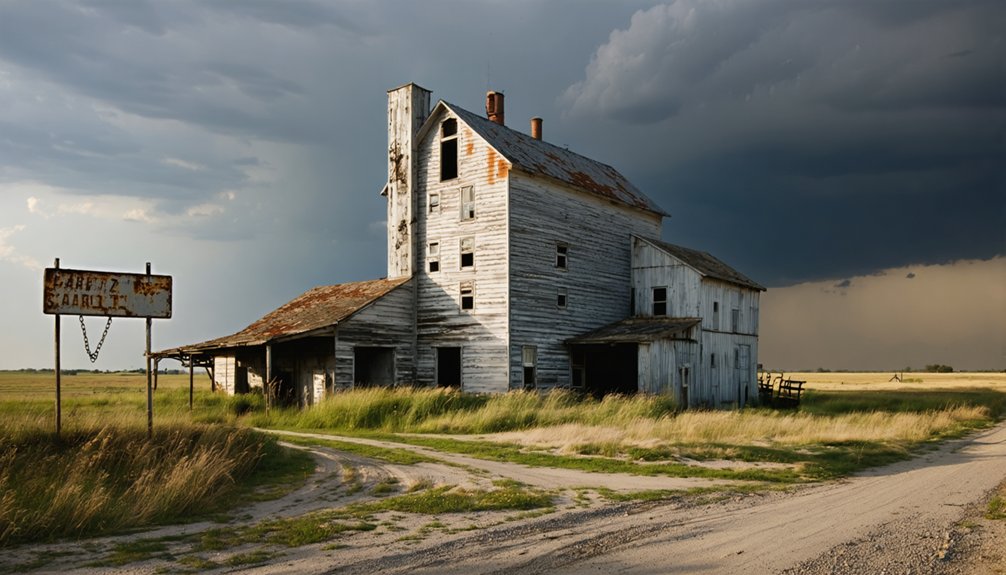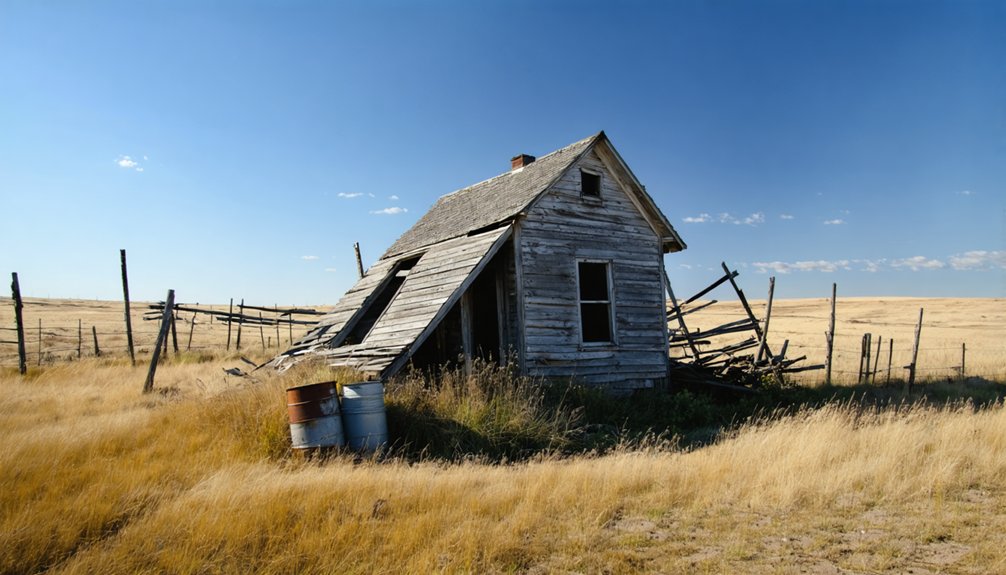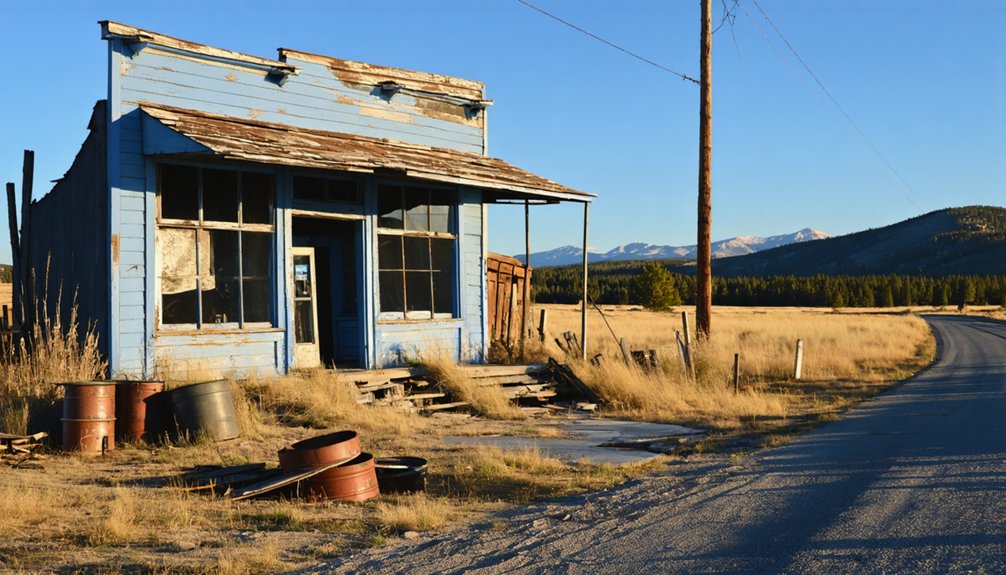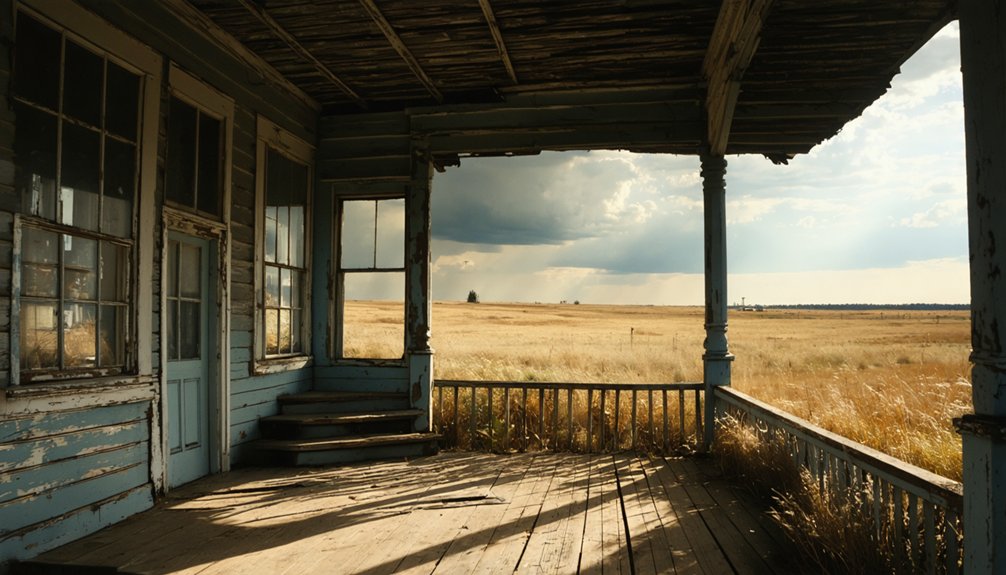You’ll find Pine Grove ghost town on the eastern edge of South Dakota’s Black Hills, near Rockerville in Pennington County. After William Wilson discovered gold there in 1866, the settlement quickly grew to 600 residents with two stamp mills, a post office, and newspaper by 1868. The Wheeler and Wilson mines produced $8 million in gold by 1893, but by the 1930s, the depleted mines led to total abandonment. The site’s crumbling foundations and cemetery markers hold deeper stories of this once-thriving mining community.
Key Takeaways
- Pine Grove was a prosperous Black Hills mining town that grew to 600 residents after gold was discovered by William Wilson in 1866.
- Located near Rockerville in Pennington County, Pine Grove is accessible from Rapid City and surrounded by Battle Creek and Iron Creek.
- The Wheeler Mine and Wilson Mine were major operations that produced $8 million in gold by 1893.
- The town declined after gold resources were depleted, transforming from a bustling mining center to a ghost town by 1918.
- Today, only deteriorating structures and mining remnants remain, with no maintained roads or visitor facilities at the site.
Location in the Black Hills
While many ghost towns dot the Black Hills landscape, Pine Grove‘s location along the eastern edge of the central Black Hills region provides visitors with convenient access from Rapid City.
Pine Grove stands as one of the Black Hills’ most accessible ghost towns, perched conveniently on the region’s eastern frontier.
You’ll find this historic site near the town of Rockerville in Pennington County, positioned at approximately 43.9079°N latitude and -103.3097°W longitude.
The surrounding geographical features include Battle Creek and Iron Creek, with their impressive Big Falls and Little Falls waterfalls nearby. The area’s peaceful setting includes a 10-acre wooded lot that borders the National Forest.
Visitors can utilize the moderately sized parking area at the eastern entrance of the trail.
You’re also within sight of prominent Black Hills landmarks like Black Elk Peak and Boulder Hill.
The area’s mature forest ecosystem exemplifies the region’s characteristic blend of pine woodlands and rocky terrain.
Foster’s Well, a historic water source, stands as a monument to the area’s pioneering past.
Historical Roots and Settlement
When William Wilson discovered gold-bearing rock in 1866, he set in motion Pine Grove’s transformation from untamed wilderness into a bustling mining settlement.
Despite initial settlement challenges, the community quickly established essential infrastructure, including two steam-powered stamp mills and three arrastras for processing ore.
You’ll find that Pine Grove’s resilience showed in its rapid growth, reaching 600 residents by the early 1870s. The settlement’s layout spread across five distinct sections, demonstrating thoughtful planning for expansion. The town’s location east of Lake Tahoe made it an ideal spot for mining operations. Like many Black Hills ghost towns, Pine Grove faced economic shifts that would eventually lead to its decline.
Community services emerged swiftly, with a post office and weekly newspaper by 1868.
The Wheeler Mine and Wilson Mine flourished, yielding a combined $8 million in mainly gold production by 1893.
Pine Grove’s development reflected the pioneering spirit that characterized Black Hills mining communities.
Community Life and Development
During Pine Grove’s peak years, the settlement bustled with a diverse population of 600 residents, including miners, merchants, and their families who formed tight-knit social bonds typical of frontier mining communities.
You’d have found strong community resilience in their shared labor and mutual support systems, centered around the local chapel that served as both a spiritual and social gathering point. Like the residents of one family in Awanka, the townsfolk maintained close connections despite dwindling numbers.
The town’s social cohesion was evident in how residents faced challenges together, from the devastating 1918-1919 influenza pandemic to frequent flooding. The residents memorialized their community bonds through plastic flowers placed on graves in the local cemetery.
Pine Grove’s strength lay in unity, as neighbors supported each other through disease outbreaks, floods, and daily hardships.
Daily life revolved around the sawmill and mining operations, with basic services like postal facilities supporting the community.
While formal educational institutions were scarce, residents adapted through informal schooling arrangements common in transient mining settlements of that era.
Mining and Economic Activities
While specific records of Pine Grove’s mining operations remain scarce, you’ll find the town followed patterns typical of Black Hills mining settlements during the region’s mineral extraction era.
The town’s history began when placer gold deposits were discovered in the 1860s, marking its early development. The area’s mines likely focused on gold and silver extraction, utilizing traditional mining methods common to South Dakota’s Black Hills mining operations. The town’s location at 6,716 feet elevation made mining operations particularly challenging in the mountainous terrain.
You can trace the town’s eventual decline through the broader economic patterns of the Black Hills mining industry, which experienced significant boom-and-bust cycles affecting resource production and community sustainability.
Mining Operations Overview
Three distinct mining operations shaped Pine Grove’s economic development in the Black Hills: placer mining along creek beds, underground lode mining in the surrounding hills, and surface mining through open cuts.
You’ll find that mining technology evolved rapidly during Pine Grove’s peak years as prospectors worked the area’s rich Precambrian deposits.
The progression of ore processing methods tells the story:
- Placer mining dominated early operations, with miners washing gold from stream gravels using simple tools and water diversions.
- Underground operations followed, driving tunnels into gold-bearing quartz veins with steam-powered drills and hoists.
- Surface mining completed the mix, where miners dug trenches and open cuts to access shallow deposits.
These operations worked in tandem, drawing both independent prospectors and larger companies to Pine Grove’s promising terrain. Early miners relied heavily on picks and shovels before transitioning to more complex scientific methods.
Resource Production Patterns
Pine Grove’s resource production followed four distinct patterns shaped by technological advances and market demands between 1876 and 1938.
Similar to the success of the Homestake Mine operation, Pine Grove initially saw significant yields that attracted investment in its early development phase.
You’ll find the first pattern centered on basic resource extraction using simple tools and manual labor, while the second phase brought improved milling operations that boosted efficiency.
The third pattern emerged with the introduction of mechanized equipment, allowing deeper mining and higher yields.
Finally, the fourth pattern saw more sophisticated extraction methods, though they carried a heavier environmental impact on the local landscape.
The town’s mining operations adapted to these shifting patterns by upgrading infrastructure and transportation systems.
You can trace Pine Grove’s economic peaks through these changes, as each new production pattern brought brief periods of prosperity before declining yields eventually led to the town’s abandonment.
Decline and Abandonment

When Pine Grove’s Wilson and Wheeler mines exhausted their gold deposits by 1918, you’d have witnessed the town’s swift transformation from a bustling mining center of 600 residents to a silent ghost town.
The exodus of miners and their families accelerated through the 1920s as the economic foundation crumbled, with the last residents departing by the 1930s.
Today, you’ll find nature has reclaimed most of Pine Grove’s former settlement areas, leaving only scattered foundations and cemetery markers as evidence of its mining-era prosperity.
Mining Resources Run Dry
Despite early success in surface gold extraction, Pine Grove’s mining operations began an irreversible decline in the late 1870s as easily accessible placer deposits were exhausted.
Resource depletion forced miners to shift from simple placer techniques to more complex quartz vein mining, but many lacked the capital and mining technology needed for deeper extraction.
- Declining ore grades and lack of advanced machinery made profitable extraction increasingly difficult.
- Competition from larger, better-funded mines in Lead and Deadwood drew away potential investors.
- Limited water resources and harsh climate conditions raised operational costs considerably.
You’ll find the town’s mines were ultimately doomed by these technical and financial barriers.
When the silver demonetization crisis hit in 1893, Pine Grove’s struggling operations couldn’t survive, leading to widespread closures and abandonment by the early 1900s.
Population Exodus Patterns
Throughout the 1880s and early 1890s, population decline in Pine Grove mirrored the fate of neighboring mining settlements like Lawrence and Pinkerton.
As mining resources dwindled, you’d have witnessed dramatic population shifts that transformed this once-bustling settlement into a barren ghost town. The exodus didn’t happen overnight – it followed a predictable pattern seen throughout the Black Hills region.
Economic factors drove the abandonment as miners and their families sought opportunities elsewhere. You can imagine the gradual emptying of homes and businesses as the mining operations became less profitable.
Today, you’ll find few traces of the original settlement, as Pine Grove has succumbed to the harsh South Dakota elements. Like many ghost towns within twenty miles of Deadwood, it stands as a monument to the boom-and-bust cycle of mining communities.
Land Reclamation Process
After Pine Grove’s mining operations ceased in the late 1890s, nature began its methodical reclamation of the land.
You’ll find that natural vegetation gradually reclaimed abandoned structures while weather patterns eroded man-made remnants. The absence of mining activity allowed wildlife habitats to flourish, though soil contamination from mining residues posed initial challenges.
- Wooden buildings and machinery deteriorated rapidly, with only stone foundations persisting
- Historical preservation efforts focused on documenting relics rather than restoration
- Ecological recovery progressed naturally, with minimal human intervention
Today, you’ll discover a delicate balance between cultural heritage and nature’s persistence.
While mining scars remain visible on hillsides, they’re softened by decades of vegetative growth. Pine Grove’s transformation from bustling mine to ghost town demonstrates nature’s remarkable ability to heal, even as it preserves hints of human history.
Current Site Conditions

The abandoned site of Pine Grove stands as a deteriorating collection of derelict structures and mining remnants, with most buildings now reduced to foundations and weathered ruins.
You’ll find site accessibility limited to foot traffic or off-road vehicles through rough terrain, as no maintained roads lead directly to the location. Native vegetation has reclaimed much of the area, creating wildlife habitats among the scattered remains.
When exploring Pine Grove, you’ll need to exercise caution due to significant visitor safety concerns. Unstable structures, loose debris, and uneven ground pose risks, while the absence of facilities means you’re exposed to harsh weather without shelter.
The remote location on public lands offers no amenities, signs, or interpretive markers to guide your visit, though you’re free to explore the historical remnants at your own pace.
Regional Ghost Town Context
Pine Grove’s ruins represent just one chapter in South Dakota’s extensive ghost town legacy, which encompasses over 245 abandoned settlements across the state.
South Dakota’s landscape is dotted with 245 ghost towns, each a silent witness to dreams that flourished and faded.
You’ll find these forgotten places scattered across the landscape, with Lawrence County hosting an astounding 93 ghost towns – second only to Kern County, California.
While urban legends and ghost stories surround many of these sites, the real history tells a compelling tale of boom-and-bust cycles.
- The Black Hills region holds a particularly dense concentration of abandoned settlements, driven by the 1874 gold rush and subsequent mining decline.
- Unlike other Western states’ ghost towns, South Dakota’s abandoned communities often tell stories of failed agricultural ventures and railroad bypasses.
- Nearly 20% of America’s tiniest ghost towns – those with 10 or fewer residents – are found within South Dakota’s borders.
Legacy in Lawrence County

Despite extensive research into Lawrence County’s documented ghost towns, compelling evidence for Pine Grove’s existence within the county remains elusive.
You won’t find Pine Grove in any official Lawrence County records, census data, or historical documents. The Pine Grove mystery deepens when you consider the county’s well-documented mining camps and boomtowns – none mention this supposed settlement.
Historical misconceptions may have arisen from confusing Pine Grove with similarly named locations elsewhere.
The absence of Pine Grove from Lawrence County’s extensive archives, including court records, land patents, and tax documents, suggests it never existed as a recognized community.
Even the county’s rich oral histories and genealogical records, which typically preserve memories of forgotten places, remain silent about Pine Grove’s presence in Lawrence County.
Frequently Asked Questions
Were There Any Notable Crimes or Lawlessness Reported in Pine Grove?
You won’t find documented crime statistics or specific law enforcement reports from Pine Grove. While typical mining-town disputes likely occurred, historical records don’t show any notable criminal incidents or widespread lawlessness.
What Native American Tribes Inhabited the Pine Grove Area Before Settlement?
Picture fierce warriors on horseback: you’d have found the Lakota Sioux tribes dominating Pine Grove’s territory, particularly the Oglala band, after they’d pushed west from Mississippi around 1775, replacing earlier Cheyenne influence.
Did Any Famous Pioneers or Historical Figures Visit Pine Grove?
You won’t find records of famous visitors at this historical landmark. Unlike Deadwood, which attracted figures like Wild Bill Hickok, Pine Grove’s documented history focuses on local miners and merchants.
What Was the Average Temperature and Rainfall in Pine Grove?
While exact records weren’t kept for Pine Grove specifically, you’ll find temperature trends mirror nearby Pine Ridge, averaging 62°F highs, 33°F lows, with rainfall averages around 17.5 inches annually.
Were There Any Natural Disasters That Affected Pine Grove’s Development?
You won’t find records of any natural disasters affecting Pine Grove’s development. The town’s decline was driven by economic impacts, particularly the 1893 depression and eventual depletion of mining resources.
References
- https://www.sdpb.org/rural-life-and-history/2023-08-21/some-black-hills-ghost-towns-and-their-origins
- https://www.youtube.com/watch?v=33PN0f-AyZk
- http://blackhillsbackroad.com/?page_id=3105
- https://westernmininghistory.com/towns/nevada/pine-grove/
- https://en.wikipedia.org/wiki/List_of_ghost_towns_in_South_Dakota
- https://nvtami.com/2023/05/22/pine-grove-cemetery-2023/
- https://www.youtube.com/watch?v=7GyUMGPTyE0
- https://www.onlyinyourstate.com/experiences/nevada/vacant-ghost-town-nv
- https://www.homes.com/property/24227-pine-grove-rd-rapid-city-sd/3qgmrymwf0jwk/
- https://www.trailsoffroad.com/US/south-dakota/scout-routes/4558-pine-grove



